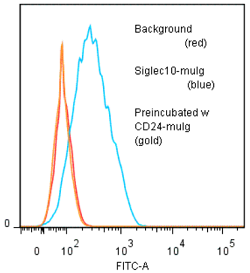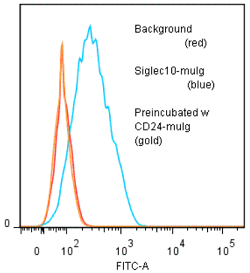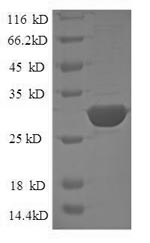CD24 (mouse):Fc (human) (rec.)
AG-40B-0065T
Protein IDP25063
Product group Proteins / Signaling Molecules
Overview
- SupplierAdipoGen Life Sciences
- Product NameCD24 (mouse):Fc (human) (rec.)
- Delivery Days Customer10
- CertificationResearch Use Only
- Concentration1 mg/ml
- Estimated Purity>90%
- Protein IDP25063
- Protein NameSignal transducer CD24
- Scientific DescriptionCD24 is a highly glycosylated protein expressed as glycosyl-phosphatidyl-inositol (GPI) anchored molecule. It is widely expressed, mainly on T cells, B cells and is upregulated in numerous types of cancers. It has costimulatory activity for antigen specific T cell responses. Polymorphisms of human CD24 are associated with several autoimmune diseases. Recently, a new role as negative regulator of the immune response has been reported. CD24-deficient mice are more sensitive to inflammatory responses. CD24 together with the membrane protein SIGLEC interacts with danger-associated molecular patterns (DAMPs), such as HMGB1, HSP90 or HSP70. CD24/SIGLEC complex may differentially regulate the host response to DAMPs and PAMPs (pathogen-associated molecular patterns). - Protein. The extracellular domain of mouse CD24 (aa 27-53) is fused at the C-terminus to the Fc portion of human IgG1. Source: HEK 293 cells. Endotoxin content: 90% (SDS-PAGE). CD24 is a highly glycosylated protein expressed as glycosyl-phosphatidyl-inositol (GPI) anchored molecule. It is widely expressed, mainly on T cells, B cells and is upregulated in numerous types of cancers. It has costimulatory activity for antigen specific T cell responses. Polymorphisms of human CD24 are associated with several autoimmune diseases. Recently, a new role as negative regulator of the immune response has been reported. CD24-deficient mice are more sensitive to inflammatory responses. CD24 together with the membrane protein SIGLEC interacts with danger-associated molecular patterns (DAMPs), such as HMGB1, HSP90 or HSP70. CD24/SIGLEC complex may differentially regulate the host response to DAMPs and PAMPs (pathogen-associated molecular patterns).
- Storage Instruction-20°C,2°C to 8°C
- UNSPSC12352202





